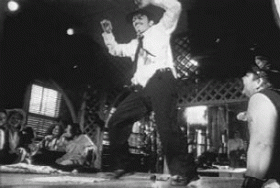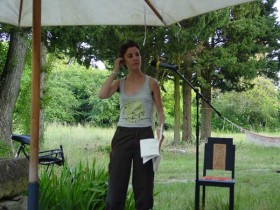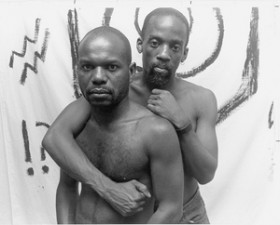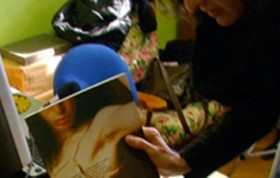As two heavily made-up women take turns directing each other and submitting to each other’s kisses and caresses, it becomes increasingly obvious that the camera is their main point of focus. Read against feminist film theory of the “male gaze”, the action becomes a highly charged statement of the sexual politics of viewing and role-playing; and, as such, is a crucial text in the development of early feminist video.
“This video is Benglis’s emphatic response to the notion of a distinctly feminine artistic sensibility and to the belief in a necessary lesbian phase in the women’s movement-ideas that were often debated in the early 1970s.” -Susan Krane, “Introduction”, Lynda Benglis: Dual Natures (Atlanta: High Museum of Art, 1991)
Sculptor Lynda Benglis executed a number of videos in the mid 1970s, continuing her exploration of female sexuality and identity-an overriding theme in her work. The interest in human form and presence in her process-oriented sculptural work finds its way into her self-reflexive, investigative videos. Benglis aggressively uses the properties of the video medium to expose the process and limitations of the form-for example, re-shooting footage on the monitor and technically manipulating the image on screen. In this way, Benglis negotiates a personal space for herself, maintaining a deliberate distance from the medium. Using her own body and creating multiples of her image, Benglis interrogates the relation of the self to the body-focusing on the interface between our inner and outer realities. Linking art world practice to feminist discourse she produced Home Tape Revised, Female Sensibility, and How’s Tricks-which together read as an anthropological study, each work forming a chapter in the “woman as nature/woman outside of culture” continuum. Within the context of feminist film theory of the gendered gaze, and contemporary theories of authorship, the importance of Benglis’s video work emerges. Sensitive not only to debates of orginality and the construction of the artistic subject, Benglis’s work consistently critiques what are believed to be video’s “inherent” properties: the sense of “real” time, its supposedly immediate and truthful relationship to the world, and its privileged viewpoint in relation to events.
This title was in the original Castelli-Sonnabend video art collection.
*Lynda Benglis (born October 25, 1941 in Lake Charles, Louisiana) is an American sculptor known for her wax paintings and poured latex sculptures. Benglis’ work is noted for an unusual blend of organic imagery and confrontation with newer media incorporating influences such as Barnett Newman and Andy Warhol. Her early work used materials such as beeswax before moving on large polyurethane pieces in the 1970s and later to gold-leaf, zinc, and aluminum. The validity of much of her work was questioned until the 1980s due to its use of sensuality and physicality.
Like other artists such as Yves Klein, Benglis’ mimicked Jackson Pollock’s flinging and dripping methods of painting.[3] Works such as Fallen Painting (1968) inform the approach with a feminist perspective. For this work, Benglis smeared Day-Glo paint across the gallery floor invoking “the depravity of the ‘fallen’ woman” or, from a feminist perspective, a “prone victim of phallic male desire”. These brightly colored organic floor pieces were intended to disrupt the male-dominated minimalism movement with their suggestiveness and openness. In 1971, Benglis began to collaborate with Robert Morris, creating Benglis’ video Mumble (1972) and Morris’ Exchange (1973). Vittorio of 1979; gold leaf, gesso, plaster, cotton, and chicken wire; in the collection of the National Gallery of Art




